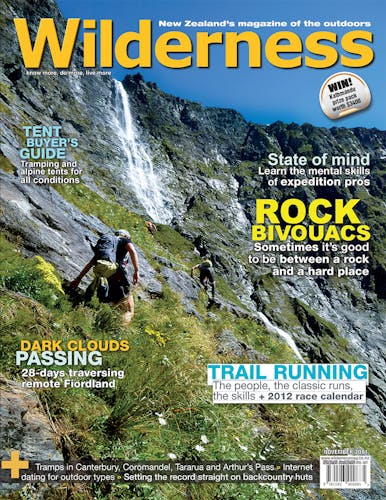Raukumara Forest Park, East Cape
The Raukumara Range contains the North Island’s most rugged mountain landscapes, and most of the vast 115,000ha Raukumara Forest Park (the North Island’s third largest) is untracked.
Established in 1979, the park is largely forested, but several peaks protrude above the bushline – notably Mt Hikurangi, which is the summit of the great chain of mountains that form the backbone of the North Island. It’s home to New Zealand’s most northerly alpine plants: speargrass, eyebrights, North Island edelweiss, everlasting daisies and the buttercup Ranunculus insignis.
Although largely undeveloped, Raukumara Forest Park does have some good opportunities for outdoor recreation. There are five huts in the range (Mangakirikiri, Mangatutara, Mangaotane – or McMillans – Oronui, and Hikurangi), one campsite, and opportunities for rafting, fishing, hunting, tramping and mountain biking. Those willing to tackle off-track terrain must be prepared to face large rivers, difficult gorges, dense bush and slow travel.
1. Mt Hikurangi (1752m)
One translation of Hikurangi (which was named after a mountain in Hawai’iki) is ‘the end of the sky’, and legends explain that the peak was the first place to emerge when Maui fished up Te Ika Nui A Maui (the North Island). Hikurangi is also the first point on mainland New Zealand to see the sun and is the highest non-volcanic peak in the North Island. Access is across Pakihiroa Station, administered by Ngati Porou, following a farm 4WD track for four hours to a carpark near Hikurangi Hut.
2. Whakairo, Hikurangi Track
In the late 1990s at the Hikurangi Hut car park, Ngati Porou erected nine impressive whakairo (carvings) representing Maui and his whanau. Designed by artist Derek Lardelli, they add a fascinating cultural element to a Hikurangi tramp.
3. Hikurangi Hut
Lying 20 minutes from the car park at an altitude of 1200m, the hut offers commanding views and forms a convenient base from which to explore Mt Hikurangi. The 12-bunk hut must be booked through the Ngati Porou Visitor Center (P: 06 864 8660, www.ngatiporou.com) and costs $15/night. From the hut, it’s 2-3hr to Hikurangi’s summit along a poled route that is rugged in places.
4. Whanakao
The precipitous, Paparoa-like summits of Whanokao lie north-west of Mt Hikurangi. Whanokao’s highest peak proved so rugged that it remained unclimbed until 1946 when Colin McLeron and Adrian Primrose reached the top. Access to the peak is through harsh country, only for those who particularly enjoy a good thrashing.
5. Raukumara Wilderness
The largest wilderness in the North Island, and one of the most rugged in the country. It was established in 1988 and spans almost 40,000ha, mostly untracked. There are three huts (Mangakirikiri, Mangatutara and Oronui) and a rough route exists on parts of the west-east traverse.
6. Motu River
The Motu River is a wild 100km watercourse with three high-walled canyons, deep pools and numerous cataracts. Rafting the Motu is one of New Zealand’s great adventures: a four-day journey through some of the North Island’s most dense bush and torturous hill country. The rapids are nowhere harder than Grade 4, yet the river’s remoteness ensures this is serious rafting proposition for experienced paddlers.
7. Mangakirikiri Hut
This six-bunk ex-Forest Service Hut is about 15 minute’s walk upstream from the junction of the Mangakirikiri Stream and the Motu River and offers the only accommodation on a Motu rafting trip aside from camping. It’s also used occasionally by parties completing a west-east traverse over the Raukumara Range.
8. Motu River mouth
After gathering all of its tributaries together, the Motu finally forgets the exuberance of youth, and embraces old age. Its midriff expands, and its rapids are few and subdued. By the time the Motu passes under SH35, it’s lost its urgency, though there is still a formidable flow. Jet boat access is possible up the lower river to White Rapid. This is an exhilarating way to experience the river if you can’t raft.
9. Whitikau Campsite
This basic campsite offers an introduction to Raukumara Forest Park. Situated at the end of Takaputahi Road, it lies at the junction of the Whitikau and Takupatahi streams, with a pleasant bush setting. It’s accessible from Opotiki via SH35 and the Old Motu Road.
10. Otipi Road mountain bike
This old road was constructed in the 1950s when plans were afoot to dam the Motu River for hydroelectricity. The outdoor community leapt to the river’s defence, and through protest and submission writing, averted the dam proposals. These days the old road offers opportunities for mountain biking and 4WD-ing, and is one of the few ways to access the Motu River overland. It’s a 60km full-day ride of about Grade 3. Slips often close the road, so check with DOC before starting.







